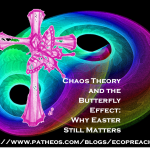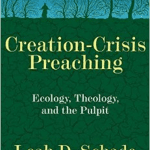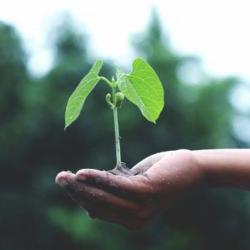A Joint Book Review of
Resisting Structural Evil: Love as Ecological-Economic Vocation, Cynthia D. Moe-Lobeda (Fortress Press, Minneapolis, MN, 2013; 309 pages; $19.80 paperback)
and
Flight Behavior, Barbara Kingsolver (Harper Perennial, New York, NY, 2012; 464 pages; $16.99 paperback)
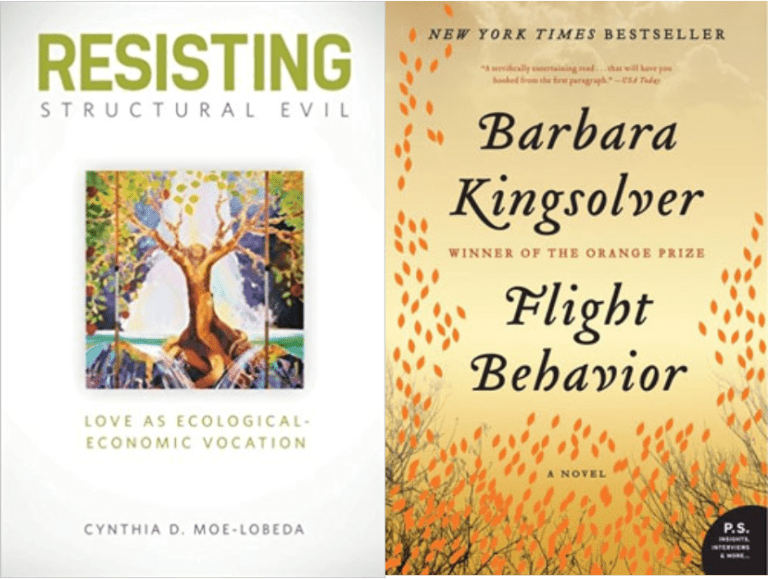
“The Butterfly Effect” is a beautiful poetic phrase used to describe the phenomenon in chaos theory wherein the course of events can be altered by some seemingly inconsequential variable. “Sensitive dependency on initial conditions” is the more scientific phrase in which a small change at one place can result in large differences in a later state. Thus, in theory, a hurricane’s formation is effected by the flapping of a butterfly’s wings in a far distant time and place.
Two recent books illustrate how inhabitants of this planet are feeling the effects of the accumulation of countless decisions on a trajectory of sometimes mindless, sometimes intentional, human domination of ecological and economic patterns. Ecotheologian Cynthia Moe-Lobeda and fiction writer Barbara Kingsolver each have contributed important works that help us understand the interconnectedness of the realities of our consumption patterns, economic structures, and cultural habits and their unintended consequences, such as poverty, climate refugees, and species extinction, to name just a few.
Needed: strategies of hope, narratives of action
Feelings of guilt, powerlessness and hopelessness can often overwhelm those of us whose eyes have been opened not only to the realities of the climate crisis, but also to our own culpability as members of the privileged class most responsible for the predicament. But as theologian Letty Russell pointed out, guilt in and of itself does not accomplish anything.[1] It is action that leads to transformation and reconciling one’s self and class to the planet and the Earth-community, inclusive of humanity. We need strategies of hope and narratives of action to enable us to see what living differently and restructuring a more just global society might look like. With their respective books, Moe-Lobeda and Kingsolver have given us examples of this kind of dot-connecting, reality-revealing and hope-engendering work.
Call it serendipity, or perhaps the leading of the Spirit, but I just happened to read these two books at the same time, not realizing the ways in which they would inform and amplify each other. Though Moe-Lobeda’s is a book of religion and ethics and Kingsolver’s a work of fiction, the two monographs are uncannily complementary. As I read them side by side, I noticed interweaving themes of ecologic/economic justice, the intra- and inter-connectedness of our global society and the planet that supports us, and the ways in which religion and spirituality can build bridges of prophetic understanding and reconciliation on a personal, community, and planetary level.
The power of narrative
What gives internal structural to each book, as well as a shared lattice in reading these two in tandem, is the use of narrative to interlace the complex ways in which economic and ecological violence are visited upon the poorest and most vulnerable around the globe. Kingsolver’s novel is a work of realistic fiction in which the protagonist, a stay-at-home wife and mother of two young children living among the rural poor along the foothills of southern Appalachia in Tennessee. Dellarobia Turnbow has a seemingly miraculous encounter with a stunning colony of migrating monarch butterflies on a mountain owned by her in-laws.
The “butterfly lady,” as she comes to be know, discovers to her increasing dismay, however, that the presence of the butterflies is no miracle, but instead a result of the monarchs’ loss of habitat in South America and a subsequent recalibration of their internal homing patterns due to climate change. As tourists, environmentalists, and scientists flock to her family’s mountain, the Turnbows are faced with their own loss of home and land when Dellarobia’s father-in-law weighs whether or not to turn the mountain over to a logging company in order to pay off crushing debt.
Moe-Lobeda’s book provides some critical terms and concepts to help us understand the powers that force families such as the Turnbows into these kinds of double-binds. They must decide between killing the land that sustains them in exchange for temporary financial relief, or protecting the resources of their land while bearing untenable burdens heaped upon them by the financial Pharaohs of our time.

Devastating loss now or later?
It is a choice that benefits only those who hold the financial reigns over us all, and needs to be seen for what it is.[2] Moe-Lobeda introduces a three-fold “critical mystical vision” or “moral vision” in which clear-eyed courage helps us to see first what is, then what is possible, and through it all, the presence of the Sacred. This in turn leads to a vision of: “1) the consequences of economic and ecological injustice woven into our lives; 2) more just and sustainable alternatives; and 3) moral-spiritual power for embracing these alternatives,” (Moe-Lobeda, 5).
Economic and ecological violence
It is economic violence and ecological violence by the financialization of our global economy that has wrought such devastating effects on the poor around the world and the planet’s biotic communities. In the wake of neoliberalism which came to prominence in the early 1980’s under the Thatcher and Reagan administrations, radical capitalism has gained ascendency which results in “‘free trade,’ financialization of economies, and the external debt of many impoverished nations.” (Moe-Lobeda, 27).[3]
Moe-Lobeda’s use of narrative brings her work into sharp focus. She includes numerous vignettes – “life stories” – to illustrate the dynamics that hold our current systems in place. From national debt in Africa, to the hazards of “trans-boundary dumping” of our consumer electronics in the Philippines, to the “free trade” that enslaves so many to poverty, to the demand for “blood minerals” for our insatiable desire for new electronics, Moe-Lobeda carefully and relentlessly builds her case, though she does so without being self-righteous. She turns the critical eye as much upon herself as she does upon the system in which she finds herself.
“Life-stories”
Kingsolver’s book could be thought of as one of these “life stories” — extended, expanded, and beautifully rendered. The chapter “Global Exchange” from Flight Behavior, for example, was particularly poignant and emblematic of the entanglement of economic and ecological violence. While Christmas shopping at a dollar store for their children, arguing about whether or not her husband Cub should oppose his father’s intent to log their land, Dellarobia sees the inextricable link between her cash-starved family and the plight of people halfway around the world:
“Here’s your Christmas stuff,” Cub said, waving at the aisles. Nobody could argue that one. The store contained enough plastic baubles to cover a hayfield.
“Great,” she said. “Family heirlooms made by slave children in China.” . . . She looked over the bins of tinselly junk and felt despair, trying to find one single thing that wouldn’t fall apart before you got it home . . . [T]here had to be armies of factory workers making this slapdash stuff, underpaid people cranking out things for underpaid people to buy and use up, living their lives mostly to cancel each other out. A worldwide entrapment of bottom feeders,” (Kingsolver, 157-9).
From moral oblivion to “critical mystical vision”
In spite of this dilemma, Moe-Lobeda contends that “corporate-and-finance-driven global capitalism is not an impenetrable fortress,” (Moe-Lobeda, xix). Further, she insists that ordinary citizens informed by this critical mystical vision and empowered by a “justice-making love” can help bring about the change that is needed for a more equitable society and to avoid depleting the life-giving energies of this planet. While the first half of her book systematically dissects our hegemonic worldviews and exposes the causes of our moral oblivion, the second half works tirelessly to help the reader rebuild a sense of hope and power based on both theory and concrete suggestions.
The life-stories begun in the first five chapters continue in the last four with innovative and inspiring ideas for enacting and living out the critical mystical vision Moe-Lobeda has in mind. These include conversations in church Bible study groups; divesting from companies that impose atrocious working conditions on women, children and people in impoverished countries; and aligning with advocacy and justice groups working to change international policies and improve workers’ lives and environmental conditions, to name just a few. Readers are given an array of possibilities for changing their relationship with the goods they purchase (or not), the people who fashion them, the Earth that produces the resources to make them, and the Divine Source whose intention is for the healthy flourishing of all peoples and biotic systems.

Pedagogical possibilities
Kingsolver’s and Moe-Lobeda’s books provide a fecund pedagogical model for teaching environmental theology, Christian ethics, and practical theology. Both the case studies and work of fiction help to concretize the concepts Moe-Lobeda describes, and students can be encouraged to wrestle with the moral and ethical dilemmas in both books. Students may also be inspired to think of other instances of ecological/environmental violence in which they unwittingly participate and begin to imagine new ways to reshape their individual and community patterns to bring about substantive equitable change.
I can heartily recommend both Moe-Lobeda’s and Kingsolver’s books for both interfaith and non-religious environmental advocacy groups looking for resources to address the intertwined complexities of economic and ecological injustice. While Moe-Lobeda identifies her Christian ethical commitments as the source of her work, she is very clear that readers need not share her faith perspective. And while the Christian milieu is prominent in Flight Behavior as the lens through which the characters view their choices, their allegiances, and their accountability, the book is neither preachy nor platitudinous.
Beyond Red/Blue politics
Both author’s treatment of the Christian faith and experience is welcome, given the gross mischaracterizations and distortions of this religion touted by the extreme Left and Right within the United States. Each writer offers pointed critiques of the way in which long-cherished beliefs can be excuses for inaction or coopted by financial powers to ensure continued domination. Yet they also use biblical and doctrinal interpretation to find innovative ways through the conundrum of unsatisfactory choices.
For example, Moe-Lobeda offers an expanded understanding of salvation “to include not only liberation from oppression but also liberation from committing or perpetrating it” (Moe-Lobeda, 59). Drawing on various trajectories of Christian theology, she states that “salvation entails the restoration of the entire created world to one in which none flourish by degrading others or otherkind,” (ibid).
This kind of salvation in Kingsolver’s story happens on various levels.
For example, the pastor of the Turnbow’s church becomes a surprisingly effective ally in Dellarobia’s efforts to preserve her family’s land. This is in a scene near the end of the book, and it makes this pastor-reviewer proud. Pastor Bobby seamlessly and subtly weaves themes of Creation-care and grace into his preaching and pastoral care, offering a positive model of a clergyperson informed and guided by ecotheological values. And Dellarobia herself finds salvation not just within her congregation, but also through the discipline of observation and hypothesis – yes, science. Learning and courage are the wings that lift Dellarobia out of her treadmill of poverty and disempowerment, even as the world she knows – the world we all know – is changing, in many ways, for the worse.
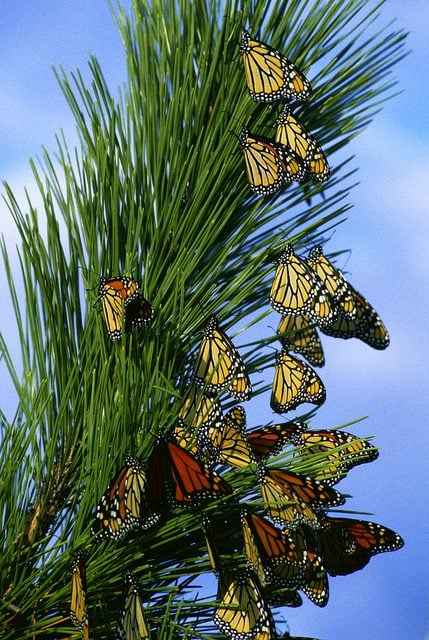
The butterfly-effect
What makes Moe-Lobeda’s work so compelling is the constant reminder that just as our current state of ecologic/economic crisis is the result of the accumulation of tiny human decisions guided by underlying values and intentions along the way. This “butterfly-effect,” when harnessed for good, means our future can be guided along a different trajectory from what we have known thus far. “One aspect of Christianity (and of some other religions) that breeds hope,” she explains, “is the claim that we are called toward some form of union with the great power of life, the source of all, what many call God. We are destined to be with or fully a part of the Holy Source, and that union begins this side of death.” (Moe-Lobeda, 138).
As we watch Dellarobia begin to think differently, make brave choices and practice alternatives in her own life, we know that these small things alone will not bring about the systemic changes that are needed. “Yet, doing so is crucial,” Moe-Lobeda declares. “It moves us toward more viable, accountable, and ecologically healthy economies on a large scale. These alternatives signal that a different way is possible” (Moe-Lobeda, 281). Therein lies the hope and optimism that finally characterize both Moe-Lobeda’s and Kingsolver’s works.
It is the accumulative effect of individuals and communities living toward God’s salvation of the planet that may cause a “butterfly effect” of neighbor-love to arise and move across our globe. God can use even the fluttering of butterflies’ wings to positively affect the patterns of this planet. Fellow butterflies – tender, tremulous, and tenacious – let us take flight!
Leah D. Schade is the Assistant Professor of Preaching and Worship at Lexington Theological Seminary (Kentucky) and author of the book Creation-CrisisPreaching: Ecology, Theology, and the Pulpit (Chalice Press, 2015).
You can follow Leah on Twitter at @LeahSchade, and on Facebook at https://www.facebook.com/LeahDSchade/.
Leah will be presenting at the Wild Goose Festival in Hot Spring, NC, July 14 and 15! Her session info is available here: http://wildgoosefestival.org/sessions17-24/. Enter the special code BEMYGUEST for a 25% discount on tickets!
For another post on how the butterfly effect helps us reframe Easter and the story of the resurrection, click here.
Notes:
[1] “The poor do not ask us to feel guilty, for they can’t eat guilt. What they ask is that we act to address the causes of injustice so they can obtain food,” (Russell, Letty M.: “From Garden to Table,” Inheriting Our Mothers’ Gardens: Feminist Theology in Third World Perspective, ed. Russell, Letty M.; Pui-lan, Kwok; Isasi-Diaz, Ada Maria; Cannon, Katie Geneva, 153).
[2] This type of environmental/economic blackmail is all too common in my state of Pennsylvania, for example, where cash-strapped farmers, landowners and local municipalities are presented with no-win situations when corporate polluters in the form of the shale gas industry, factory farms, and sludge-producers come knocking.
[3] “‘Financialization’ refers to the ‘increasing role of financial motives, financial markets, financial actors, and financial institutions in the operations of the domestic and international economies.’ . . . Financialization redirects capital toward achieving short-range high profits for its owners despite the terrible costs to many others.’” Moe-Lobeda, 3 (quoting Gerald Epstein, “Introduction: Financialization and the World Economy,” in Gerald Epstein, ed., Financialization and the World Economy [Cheltenham, UK: Edward Elgar, 2005]).


